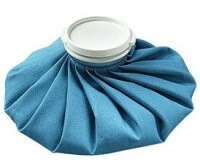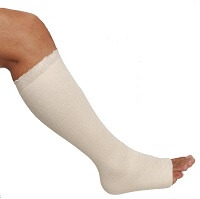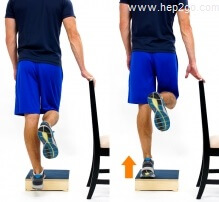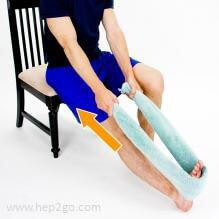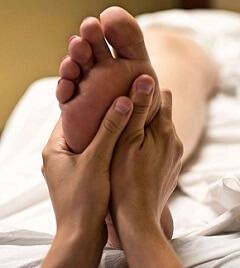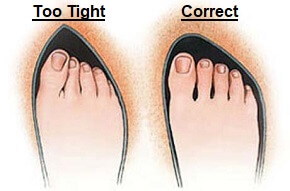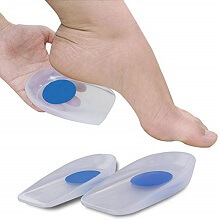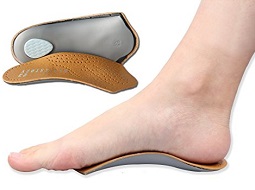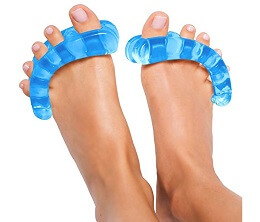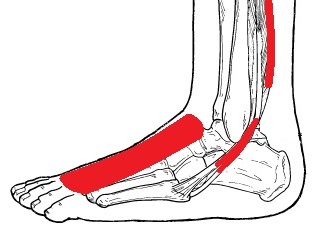- Home
- Treatment Guide
Foot Pain Treatment Guide
Written By: Chloe Wilson BSc(Hons) Physiotherapy
Reviewed By: FPE Medical Review Board
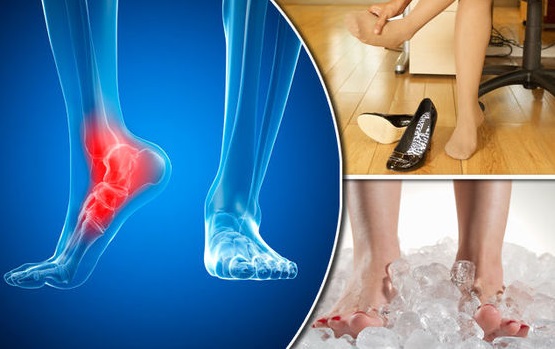
Foot pain treatment looks to reduce any pain, inflammation, instability and weakness associated with foot and ankle problems.
To be effective, ankle and foot treatment should address both the cause of the problem e.g. weakness or abnormal foot biomechanics, and the symptoms e.g. pain and swelling.
There are a whole range of foot pain treatment options out there, depending on what is causing your pain. Foot and ankle pain treatment may include exercises, orthotics, first aid treatment, or specially designed foot products such as toe stretchers.
General Foot Pain Treatment
Here we will start by look at general ankle and foot pain treatment that can be helpful in most situations, then we'll look at treatment options for specific conditions, and finally we'll look at how using orthotics in your shoes can really help.
1. R.I.C.E.
The best first line foot pain treatment option with any new incidence of pain is usually RICE - Rest, Ice, Compression and Elevation. RICE treatment for foot and ankle pain aims to protect the foot from any further injury, as well as reducing pain and inflammation. When used effectively, it can help reduce the impact of an injury and can help to speed up healing.
Find out more about how to safely and effectively use RICE treatment.
2. Foot Pain Medications

There are a whole range of medications used for the treatment of foot pain. They may to simple analgesics such as paracetamol/Tylenol that help reduce foot and ankle pain, or anti-inflammatories e.g. ibuprofen/Advil that can help to reduce swelling.
You should always consult your doctor before starting on any medications as part of your foot pain treatment.
3. Ice/Heat
Applying ice and/or heat is one of the old favourite foot pain treatments. Ice tends to be most beneficial in the first few days following an injury, such as an ankle sprain, where it helps to reduce inflammation and pain.
Heat is generally best used for longer term foot problems, helping to reduce pain
and boost circulation which can help with healing.
With Ice Treatment, it is really important that it is applied safely and correctly otherwise it can actually cause more harm than good. Visit the ice treatment section to find out how to use ice safely and effectively.
For heat treatment, a simple hot water bottle wrapped up or a microwaveable wheat bag work really well. They should be applied for about twenty minutes at a time. To avoid the risk of burns, there should always be a layer of material between them and the skin, they should be avoided if the sensation is at all reduced and should be warm rather than hot.
4. Tubigrip Compression Bandage
Tubigrip elasticated bandages are a great, simple way to provide some compression to the foot, ankle and calf. It really helps to reduce swelling and also gives some gentle support.
Tubigrip is easy to apply and cheap to buy. It can be useful both in the short term after foot and ankle injuries or for longer term conditions.
To find out more about how tubigrip works, find answers to frequently asked questions about it and how to get the right size, visit the tubigrip section on our sister site.
5. Foot Strengthening Exercises
Exercises to combat weakness in the foot and calf muscles is a vital part of ankle and foot pain treatment for virtually any foot problem. The muscles need to be able to work effectively together to support the foot and maintain the foot arches as well as controlling how the foot moves. As well as having good strength, they also need to have good endurance i.e. be able to keep working all day without tiring.
In the the foot and ankle strengthening section you will find a whole range of exercises to build up the strength and support around your ankle as part of your foot pain treatment.
6. Foot Stretching Exercises
Stretches are another really useful tool with foot and ankle pain treatment. As well as having good strength in the muscles, you also need good flexibility. Tightness in the foot and calf muscles makes subtle changes to the position of the foot and how forces are transferred up the leg. Tight muscles make us more prone to injury and pain and can slow down the healing process.
Visit the foot and ankle stretches section to find out how to effectively stretch the different muscles around the foot as part of your foot pain treatment.
7. Acupuncture
Acupuncture can be used as part of a foot pain treatment program to reduce pain without the need for medication. Acupuncture works by the insertion of very small needles into the soft tissues at various places around the body which blocks pain signals from the brain and improving circulation.
Whilst the evidence into the effectiveness of acupuncture is inconclusive at the moment, is a certainly a good option if other things are not working. It should only ever be carried out by a fully trained and licensed acupuncturist.
8. Foot Reflexology
Reflexology is an increasingly popular complementary therapy to reduce pain and stress, and promote healing and relaxation. It involves using specialised massage techniques on various points of the feet and hands that correspond to different areas of the body to improve the flow of blood, nutrients and energy through the body.
As well as helping to treat foot pain it can also help with a variety of conditions elsewhere in the body such as headaches and digestion issues. Reflexology is a safe, non-invasive technique which is easy to learn so you can self treat.
You can find out loads more about how it works and the benefits and side effects in the foot reflexology section.
Foot & Ankle Pain Treatment For Specific Conditions
So far we have look at general treatment methods for foot pain. Most of these will help with most causes of foot and ankle pain, but you can also find out more in-depth treatment information for the following conditions:
- Ankle Sprain Treatment: how to make a full recovery from ligament sprains and reduce the risk of further injuries
- Plantar Fasciitis Treatment: how to treat the symptoms and causes of plantar fasciitis, a common cause of pain under the foot
- Bone Spurs Treatment: loads of great ideas for how to deal with these bony lumps that most commonly develop on the heel
- Bunion Treatment: the best ways to treat all grades of foot bunions, with everything from orthotics, to exercises to surgery
- Swollen Foot Treatment: top 10 ways to reduce foot and ankle swelling quickly and effectively
- Foot & Ankle Rash Treatment: how to treat and prevent a whole range of foot rashes
- Plantar Fibroma Treatment: How to treat fibroma nodules underneath the foot
Footwear and Orthotics
What we wear on our feet has a big impact on the health of our feet.
Shoes that are too narrow, too tight or without enough support and protection frequently cause foot problems with the bones, muscles, ligaments and nerves. Shoes should ideally have a wide toe box, cushioned, flat soles and should be supportive but not tight.
Any biomechanical problems in the foot which affect your foot position, such as having flat feet, make us more prone to foot problems. These can often be corrected by using orthotics (special inserts) in your shoes which can often be purchased off the shelf but in more complex cases they may need to custom made. There are a number of different styles of orthotics that can be used as part of foot pain treatment depending on what is wrong:
1. Heel Cups
Heel cups simply slip into the back of your shoe. They work in two ways. Firstly, they provide cushioning and help to reduce the forces going through the heel when you walk or run. Secondly, they lift your heel up slightly which reduces the tension through the achilles tendon and calf muscles. They sound simple, but they really help to reduce foot pain.
They are particularly useful if you are suffering from achilles tendonitis, a calf strain, plantar fasciitis or heel bones spurs. You can find out more about heel cups including which brands are most popular for foot pain treatment.
2. Orthotic Insoles
Orthotic insoles help to correct abnormal foot biomechanics such as fallen foot arches, more commonly referred to as flat feet, a common cause of foot problems such as plantar fasciitis. This helps ensure that the forces that go through the foot and up the leg to the back are transferred in the correct way (flat feet often contribute to knee and back problems).
Insoles may be full length, supporting the entire foot, or half length, supporting the heel and foot arch. Find out more about using orthotic insoles as part of your foot pain treatment.
3. Toe Stretchers
Toe stretchers are a simple yet effective foot pain treatment for a number of soft tissues problems such as plantar fasciitis, bunions and hammer toe. They are often popular with runners to help stretch the feet out before and after a run.
They help to stretch out the muscles, ligaments and tendons in the feet increasing flexibility. There are a number of different styles on the market - to find out how they work, and which ones are most effective, visit the toe stretchers section.
NB You should discuss the use of orthotics with your doctor, physio or an orthotist to find out if you would benefit from using them as part of your foot pain treatment and what style would be best. In most cases, you will need to wear orthotics in both shoes to ensure body weight is equally balanced through each leg.
What Else Can Help?
To get the most out of foot pain treatment, it is really important to understand what is causing your pain in the first place. Visit the common foot problems section for information on the most common causes of foot pain, or if you want some help working out what is causing your pain, visit the foot pain diagnosis section.
To find out more about each ankle and foot pain treatment and how to get the best results, simply use the links above.
Related Articles
Page Last Updated: 2nd October, 2024
Next Review Due: 2nd October, 2026
